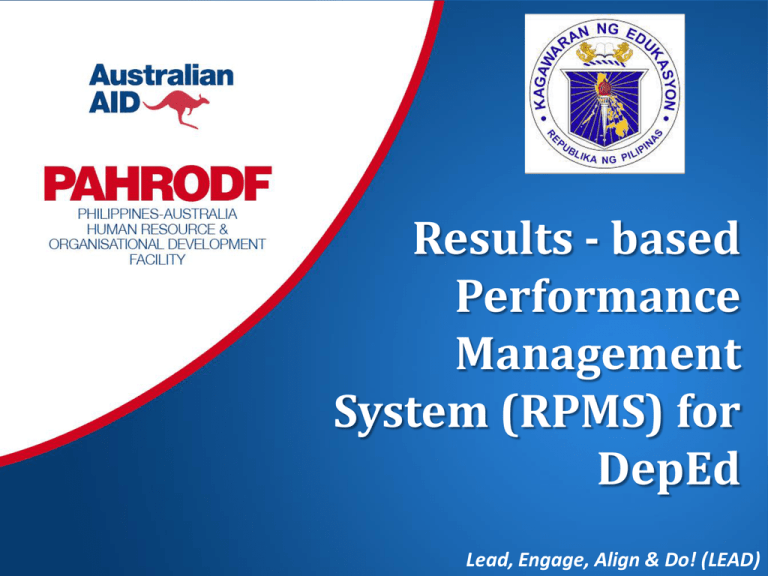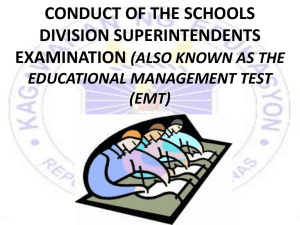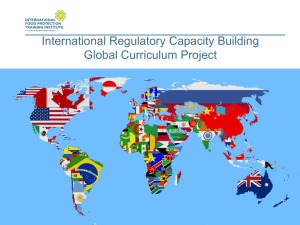RPMS Overview - WordPress.com
advertisement

Results - based Performance Management System (RPMS) for DepEd Lead, Engage, Align & Do! (LEAD) RPMS Key Deliverables 1. Conceptualization / Design • • • • • • 2. 3. 4. Briefing of Technical Working Group on Proposed Methodology Benchmarking Workshop on Identifying Competencies on breaking down strategic priorities into KRAs and Objectives Validation Workshops Final Draft presented to Technical Working Group Documentation (Facilitator’s Guide, Manager’s Manual, Employee’s Manual, Forms) Crafting of Position Profiles / Validation / Change Management / Communication Workshop Approval of Civil Service Commission Pilot Test DepEd Vision We dream of Filipinos who passionately love their country and whose values and competencies enable them to realize their full potential and contribute meaningfully to building the nation. As a learner - centered public institution, the Department of Education continuously improves itself to better serve its stakeholders. DepEd Mission To protect and promote the right of every Filipino to quality, equitable, culture-based, and complete basic education where: • Students learn in a child-friendly, gender-sensitive, safe and motivating environment. • Teachers facilitate learning and constantly nurture every learner. • Administrators and staff, as stewards of the institution, ensure an enabling and supportive environment for effective learning to happen. • Family, community and other stakeholders are actively engaged and share responsibility for developing life-long learners. DepEd Core Values • Maka-Diyos • Makatao • Makabayan • Makakalikasan The DepEd’s Strategic Planning Process is aligned with the Results framework of DBM-OPIF. DepEd’s Framework Based on DBM’s OPIF Inclusive Growth and Poverty Reduction Societal Goal Sectoral Outcomes Equitable Access to Adequate Quality Societal Services and Assets Sub-Sector Outcomes Knowledge, skills, attitude and values of Filipinos to lead productive lives enhanced Organizational Outcomes Improved Access to Quality Basic Education Major Final Output (MFOs) 1 2 Basic Education Services Education Governance 3 Regulatory and Developmental Services for Private Schools Filipino Artistic & Cultural Traditions Preserved & Promoted 4 5 Informal Education Services -Children Television Devt. Services Book Industry Devt. Services Mandate from DEPED The PMS Concept: Development Impact Strengthen Culture of Performance and Accountability in DepEd K to 12 School Based Management ACCESs Improved Access to Quality Basic Education Functional Literate Filipino With 21st century skills • FOCUS: Performance Measures at the Organizational, Divisional or Functional and Individual Levels • EMPHASIS: Establish strategic alignment of Organizational, Functional and Individual Goals 9 WHAT VISION, MISSION, VALUES (VMV) Strategic Priorities Department/ Functional Area Goals KRAs and Objectives HOW Values CENTRAL REGIONAL Competencies DIVISION SCHOOLS DEPED RPMS FRAMEWORK The framework aligns efforts to enable DepEd to actualize its strategic goals and vision. The DepEd RPMS is aligned with the SPMS of CSC which has 4 Phases: 1. Performance Planning and Commitment 4. Performance Rewarding and Development Planning 2. Performance Monitoring and Coaching 3. Performance Review and Evaluation What is Performance Management? An organization-wide process to ensure that employees focus work efforts towards achieving DepEd’s Vision, Mission and Values (VMV). A systematic approach for continuous and consistent work improvement and individual growth. Objectives of the Performance Management System • Align individual roles and targets with DepEd’s direction. • Track accomplishments against Objectives to determine appropriate corrective actions, if needed. • Provide feedback on employees’ work progress and accomplishments based on clearly defined goals and objectives. • A tool for people development. RPMS Linkages to Other HR Systems Agency Planning and and Directions Career Succession Training and Manpower Development Rewards and Recognition HR Planning and Recruitment RPMS Employee Relations Job Design and Work Relationships Compensation and Benefits Overall Design of DepEd RPMS Lead, Engage, Align & Do! (LEAD) General Features 1. Anchored on the Vision, Mission and Values (VMV) of DepEd. 2. CSC mandates 100% results orientation to make it uniform with other government agencies. Competencies are used for development purposes. 3. Coverage : All regular managers and employees of DepEd; teaching and non-teaching staff. 4. Basis for rewards and development. 5. Covers performance for the whole year. RPMS Cycle Non Teaching Positions Performance Planning Q1 January Mid-Year Review July Year-End Results Q4 December Teaching Positions Performance Planning Mid-Year Review Q1 June November Year-End Results Q4 March Forms The mechanism to capture the KRAs, Objectives, Performance Indicators and Competencies is the Performance Commitment and Review Form (PCRF). It is a change in mindset! DepEd Forms 1. Office Performance Commitment and Review Form (OPCRF) 2. Individual Performance Commitment and Review Form (IPCRF) • Managers • Staff and Teaching - related Employees • Teaching Components of Performance Management What = Results (Results & Objectives of a position) + How = Competencies (Skills, Knowledge & Behaviors used to accomplish results) Phase 1 Performance Planning and Commitment 1. Discuss Unit’s Objectives 2. Identify Individual KRAs, Objectives and Performance Indicators 3. Discuss Competencies Required and Additional Competencies Needed 4. Reaching Agreement 1. Discuss Unit’s Objectives The Office head discuss the office’s KRAs and Objectives with direct reports. Then, break this down to individual KRAs and Objectives. 2. Identify KRAs, Objectives and Performance Indicators Identify your responsibilities by answering the following question: “What major results/outputs am I responsible for delivering?” What is the definition of KRAs? KRAs define the areas in which an employee is expected to focus his/her efforts. What is the definition of Objectives? Objectives are the specific things you need to do, to achieve the results you want. SMART Criteria for Objectives Review SMART Criteria Specific Well written objectives are stated in specific terms to avoid any confusion about what is to occur or what is to improve Measurable It is important to define measurements that enable progress to be determined and results to be measured. A measurable objective defines quantity, cost or quality. Effectiveness Effectiveness can include both quality and quantity. Example: Achieved a rating of 4 in running all batches of train-the-trainers program. Efficiency To measure cost specifically: money spent, percentage over or under budget, rework or waste Example: Do not exceed Php 100,000 a month in running 2 training programs. Timeliness Measures whether a deliverable was done correctly and on/before the deadline. Example: Timely submission of quarterly reports. reports Attainable Should be challenging yet attainable, something the person can influence to effect change or ensure results Relevance • Objectives that state your share of specific department / functional areas goals • Aligned with the directions of the unit Time Bound Objectives must be time bound. Example: • Achieved running 20 RPMS program within 2014. • Responded to all participants’ suggestions one week after the meeting. • Did not exceed Php 200,000 a month for conducting a workshop. Example KRAs Objectives Posted 20 vacant positions within the CSC prescribed period and per requirements (for 1st, 2nd, and 3rd level positions) Recruitment and Selection Processes Gathered and submitted required documents for 20 nominees for screening by the PSB/NSC Processed 20 appointment papers for selection and promotion before June 2014 Conducted one-day orientation seminar for 20 newly hired employees within two weeks upon hiring Identify Performance Indicators or Measures (refer to PCPs) Performance Indicators • They are EXACT QUANTIFICATION OF OBJECTIVES. • It is an assessment tool that gauges whether a performance is good or bad. • Agree on acceptable tracking sources Example 1 Example 2 3. Discuss Competencies Required and Additional Competencies Needed Why do we have Competencies? • The RPMS looks not only at results, but HOW they are accomplished. • Competencies help achieve results. • Competencies support and influence the DepEd’s culture. • For DepEd, competencies will be used for development purposes (captured in the form). Manager’s Competencies Core Behavioral Competencies Leadership Competencies • Self Management • Professionalism and ethics • Results focus • Teamwork • Service Orientation • Innovation •Leading People •People Performance Management •People Development Staff & Teaching-related Competencies Core Behavioral Competencies • Self Management • Professionalism and ethics • Results focus • Teamwork • Service Orientation • Innovation Staff Core Skills •Oral Communication • Written Communication • Computer/ICT Skills Teaching Competencies Core Behavioral Competencies • Self Management • Professionalism and ethics • Results focus • Teamwork • Service Orientation • Innovation Teaching Competencies • Note: CB – PAST was used as basis for the new PCPs for teaching positions. •Achievement •Managing Diversity •Accountability 4. Reaching Agreement Once the form is completed : KRAs + Objectives + Performance Indicators + Competencies 1. Rater schedules a meeting with Ratee. 2. Agree on the listed KRAs, Objectives, Performance Indicators and assigned Weight per KRA. 3. Where to focus on the Competencies Rater and Ratee agree on the Key Result Areas (KRAs), Objectives, Performance Indicators and assign Weight Per KRA and sign the Performance Commitment and Review Form (PCRF). Phase 2 Performance Monitoring and Coaching 1. Performance Tracking 2. Coaching/Feedback Heart of the RPMS “If you want it, measure it. If you can’t measure it, forget it.” – Peter Drucker WHAT GETS MEASURED GETS DONE! 1. Performance Monitoring Why is it important? • Key input to performance measures. • Provides objective basis of the rating. • Facilitates feedback. • Clearly defines opportunities for improvement. • Provides evidence. No monitoring, no objective measurement. Critical Incidents • Actual events where good or unacceptable performance was observed • Provides a record of demonstrated behaviors/ performance • Effective substitute in the absence of quantifiable data, observed evidence of desired attribute or trait STAR Approach Situation Task Action Result/s *developed by Development Dimensions International (DDI) Writing S/TARs Situation/ Task Action Result “Last December, during the work planning period, you took the opportunity to review our unit’s work process. You assembled a team of your colleagues and brainstormed on improvement ideas. As a result, our turnaround time on processing promotions was reduced from 3 days to 1 day.” *developed by Development Dimensions International (DDI) To be effective in this phase you should: • Track your performance against your plan. • Use JOURNALS! *developed by the Civil Service Commission (CSC) Remember: • Manage the system as a process, NOT a one-time event! • It is NOT a year-end paper exercise. • It is important to teach performance on certain frequencies and provide feedback and coaching. 2. Coaching/Feedback For the Raters: During Performance Phase always: • Provide COACHING to your subordinates to improve work performance and behavior. • Provide FEEDBACK on the progress of work performance and behavior change. For the Ratees: • During Performance Phase, always seek the coaching of your leader specially when you realize that you need improvements in your results. • FEEDBACK: Know where and how to get helpful feedback for important aspects of your job Phase 3 Performance Review and Evaluation 1. 1. Review Performance Reviewing Performance 2. Discuss Strengths and Improvement Needs 1. Review Performance Results and Competencies A successful review session should: • Be a positive experience • Have no surprises • Be a two-way discussion • Well prepared (both sides) Note: The Rater should set a meeting with the Ratee. Request the Ratee to do self-assessment. Some Pointers on Conducting the Review Meeting: 1. Manage the meeting • Prepare for the meeting • Create the right atmosphere • No interruptions; no surprises 2. Enhance or maintain self-esteem • Express appreciation • Encourage self-appraisal • Focus on the performance issue, not on the person 3. Be fair and objective • Base assessments on evidence • Change the behavior, not the person • Focus on solving problems or correcting a behavior 4. Empower the employee • Ask him for ideas on how to resolve a problem or improve performance • Adopt a joint problem-solving approach • Be supportive Performance Evaluation is not: Attack on employee’s personality Monologue A chance to wield power and authority Paper activity (compliance) An opportunity to gain “pogi points” with staff Steps for Evaluating Objectives and Competencies Evaluate each objective whether it has been achieved or not. Evaluate the manifestations of each competency. Determine overall rating. Rating Performance Fill up the Performance Evaluation worksheet Reflect actual results / accomplishments Rate each objective using the rating scale Compute final rating CSC’s Revised Policies on the Strategic Performance Management System (SPMS) MC 13 s. 1999 Scale Adjectival 5 Outstanding (130% and above) Description Performance exceeding targets by 30% and above of the planned targets; from the previous definition of performance exceeding targets by at least fifty (50%). Very Satisfactory (115%-129%) Performance exceeds targets by 15% to 29% of the planned targets; from the previous range of performance exceeding targets by at least 25% but falls short of what is considered an outstanding performance. 3 Satisfactory (100%-114%) Performance of 100% to 114% of the planned targets. For accomplishments requiring 100% of the targets such as those pertaining to money or accuracy or those which may no longer be exceeded, the usual rating of either 10 for those who met targets or 4 for those who failed or fell short of the targets shall still be enforced. 2 Unsatisfactory (51%-99%) Performance of 51% to 99% of the planned targets. 1 Poor (50% or below) Performance failing to meet the planned targets by 50% or below. 4 *DepEd’s Competencies Scale Scale Definition 5 Role model 4 Consistently demonstrates 3 Most of the time demonstrates 2 Sometimes demonstrates 1 Rarely demonstrates 5 (role model) - all competency indicators 4 (consistently demonstrates) – four competency indicators 3 (most of the time demonstrates) – three competency indicators 2 (sometimes demonstrates) – two competency indicators 1 (rarely demonstrates) – one competence indicator *will be used for developmental purposes 2. Discuss Strengths and Improvement Needs Phase 4 Performance Rewarding and Development Planning 1. Rewards 2. Development Planning 1. Rewards Link to PBIS (EO 80 s. 2012) • Performance Based Bonus (PBB) • Step Increment 2. Development Planning • Employee development is a continuous learning process that enables an individual to achieve his personal objectives within the context of the business goals. • Employee development is a shared responsibility among the Individual, Manager, HR and the Organization. Steps in Development Planning 1. Identify development needs 2. Set goals for meeting these needs 3. Prepare actions plans for meeting the development need • sanction learning activities • resources / support • measures of success 4. Implement Plans 5. Evaluate Activities which could be considered appropriate for employee development: • Benchmarking • Functional cross-posting • Seminars/workshops • Geographical cross-posting • Formal education/classes • Coaching/counseling • Assignment to task forces/committees/ special projects • Developmental/lateral career moves • Self-managed learning • Job enhancements / redesign Development Principles 30/30/40 Learning Philosophy The key elements to a successful learning process: • 30% from real life and on-the-job experiences, tasks and problem solving. This is the most important aspect of any learning and development plan. • 30% from feedback and from observing and working with role models – mentoring and coaching. • 40% from formal training. “Behind every successful person, there is one elementary truth. Somewhere, someway, someone cared about their growth and development.” - Donald Miller, UK Mentoring Programme









